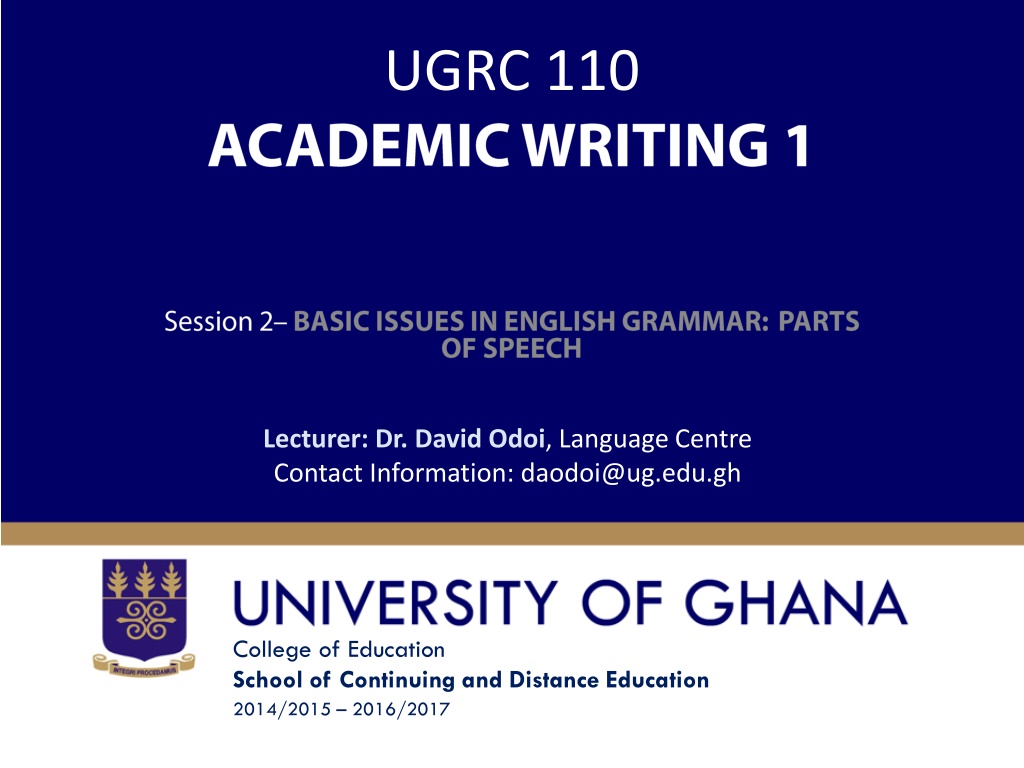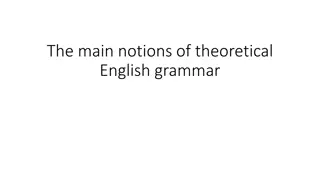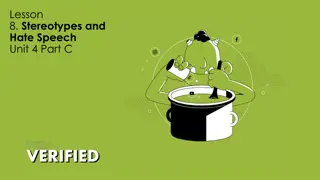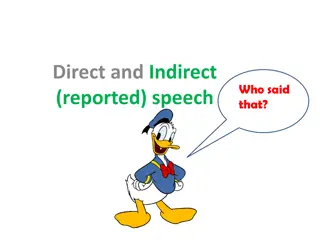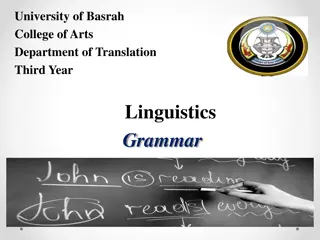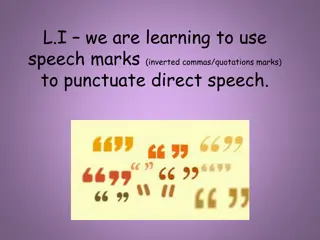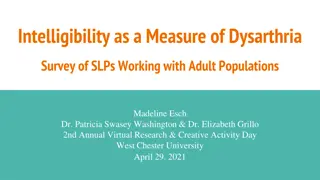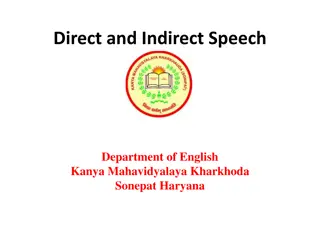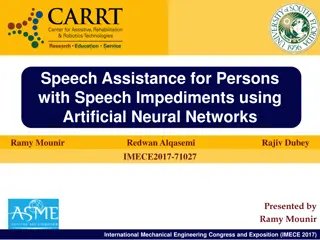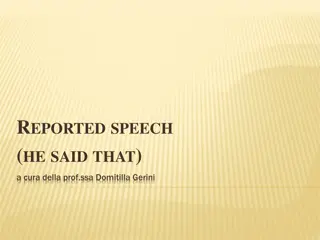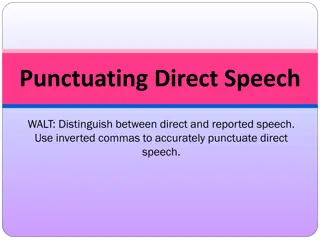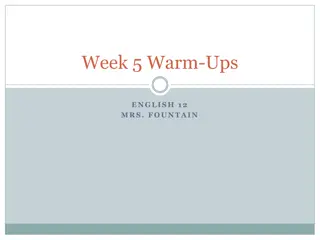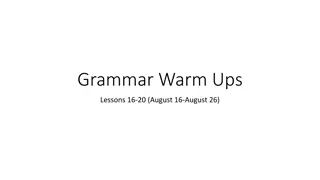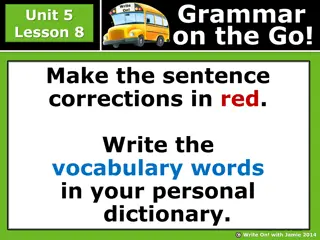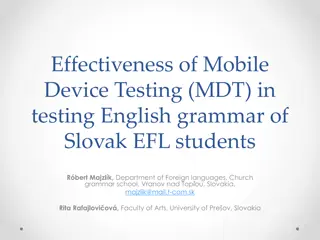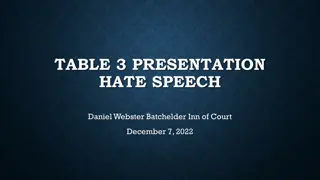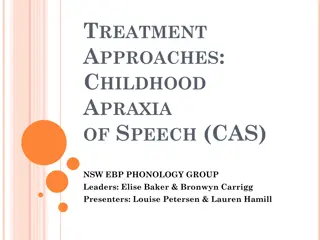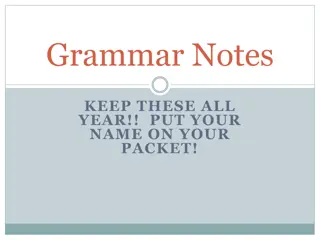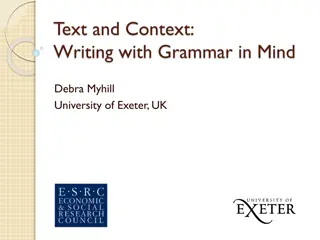Parts of Speech in English Grammar with Dr. David Odoi
Dive into the fundamental aspects of English Grammar with Dr. David Odoi at the Language Centre. Explore Nouns, Pronouns, and Verbs while learning about the different types of nouns such as Proper, Common, Collective, Concrete, and Abstract nouns. Understand countable and uncountable nouns and their usage in sentences.
Download Presentation

Please find below an Image/Link to download the presentation.
The content on the website is provided AS IS for your information and personal use only. It may not be sold, licensed, or shared on other websites without obtaining consent from the author.If you encounter any issues during the download, it is possible that the publisher has removed the file from their server.
You are allowed to download the files provided on this website for personal or commercial use, subject to the condition that they are used lawfully. All files are the property of their respective owners.
The content on the website is provided AS IS for your information and personal use only. It may not be sold, licensed, or shared on other websites without obtaining consent from the author.
E N D
Presentation Transcript
UGRC 110 Lecturer: Dr. David Odoi, Language Centre Contact Information: daodoi@ug.edu.gh College of Education School of Continuing and Distance Education 2014/2015 2016/2017
Session Overview In this session you will learn about a very basic but important topic in English Grammar, specifically, about the Parts of Speech. Parts of speech refer to the groups into which words are divided according to their functions in an English sentence. identify the various parts of speech in the English Language note the functions of the various parts of speech in an English sentence Slide 2 Dr. David Odoi, Language Centre
Session Outline The key topics to be covered in the session are as follows: Nouns Pronouns Verbs Slide 3 Dr. David Odoi, Language Centre
Reading List Read Oxford Practice Grammar by George Yule (2006) Slide 4 Dr. David Odoi, Language Centre
TOPIC ONE NOUNS Slide 5 Dr. David Odoi, Language Centre
NOUNS A noun names a person, a place, a thing or an idea. Nouns are further divided into various groups. Proper nouns name specific people (John Mensah), places (Accra) or thing (Peugeot). They always begin with a capital letter. For example, in the following sentence, the proper nouns in the sentence are underlined. Akua drove to Kumasi in a very old Toyota in April. Common nouns are names of one or more of a general class, place, thing, or idea and these are not written with capital letters. For example, the underlined words in the following sentence are common nouns. A festival is a celebration of an event. Collective nouns are names of groups (class, team) concrete nouns name physical things that we can touch or see (paper, table abstract nouns name things we cannot touch or see physically such as qualities, beliefs and conditions. For example, love, faith, and trust. The nouns in the following sentences are examples of collective, concrete, and abstract nouns respectively: The little girl welcomed her with a bouquet of flowers. The book was on the table. Honesty is a good virtue. Slide 6 Dr. David Odoi, Language Centre
NOUNS Most nouns express number that is, they can be singular or plural. These are also further divided into countable and uncountable nouns. Countable nouns name items that can be counted and they are made plural by adding s or es to the noun. For example, one boy or two boys; one class or three classes. You should note however that some countable nouns have irregular plural forms as in the case of tooth and teeth, mouse and mice. Uncountable nouns are items that cannot be counted, for example, water, sand, knowledge and many others. Most uncountable nouns do not have plural forms. Slide 7 Dr. David Odoi, Language Centre
Activity There are 25 nouns in the following paragraph. Underline the nouns in the paragraph. I had first heard of Grace Wiley some years before when Dr. Williams Mann, the director of the National Zoo handed me a picture of a tiny woman with a gigantic king cobra draped over her shoulders like a garden hose. The snake had partly spread his hood and was looking intently into the camera while its mistress stroked its head to quiet it. Dr. Mann told me: Grace lives in a little house full of poisonous snakes, imported from all over the world. She lets them wander around like cats. There s been more nonsense written about snakecharming than nearly any other subject Slide 8 Dr. David Odoi, Language Centre
TOPIC TWO PRONOUNS Slide 9 Dr. David Odoi, Language Centre
PRONOUNS Pronouns are words that are used in place of nouns and they come in different forms. The noun or pronoun to which a pronoun refers is called the pronoun santecedent. For example; After the herbalist developed a new drug for malaria, he became famous. The noun herbalist is the antecedent of the pronoun he. Pronouns come in three forms that describe the pronoun s function in a sentence. These forms are the subjective case, the objective case, and the possessive case. The subjective case (also known as subject pronouns), such as I, you, he, she, it, we, and they indicates that the pronoun is the doer of the action described in the sentence. Look at the function of the word they in the following sentence. They asked questions about my family. The word they is the doer of the action described in the verb asked. Slide 10 Dr. David Odoi, Language Centre
Pronouns The objective case (also known as object pronouns) indicates that the pronoun is the object, that is, the receiver of an action. Examples are; me, you, him, her, it, us, and them. In this example, the underlined word is an object pronoun. The manager threatened her. The pronoun her is the recipient of the action threatened The possessive case indicates ownership or belonging. The following are all possessive pronouns: my, mine, your, yours, his, her, hers, its, our, ours, their, theirs. Example: Their enthusiasm for the company does not match ours. The words their and ours show a possession of the noun enthusiasm. Slide 11 Dr. David Odoi, Language Centre
Pronouns Pronouns also specify the person, in order to indicate the speaker, the person spoken to and the person or thing spoken about. The pronouns (I, we) are normally called first person, that is, the speaker. The person spoken to, is known as the second person (you) the person or thing spoken about, is known as the third person (he, she, it, they). The gender of the person is also specified by personal pronouns. We have examples as (he, him) as masculine and (she, her), as feminine and (it) is neuter. Pronouns also specify number, that is, singular (one person or thing: I, you, he, she, it) or plural (more than one person or thing: we, you, they) Slide 12 Dr. David Odoi, Language Centre
Pronouns There are also demonstrative pronouns: this, that, these, and those which point out a particular person or thing, as indicated in the following example. These research procedures are questionable The word thesein the sentence above is a demonstrative pronoun that refers to noun research procedures and it also shows that the noun is near to the speaker. Another type of pronoun is known as a reflexive pronoun. This indicates that a subject performs actions to, for, or on itself. Reflexive pronouns end in self or selves as found in myself, ourselves, yourself, yourselves, themselves. For example; We gave ourselves two hours to complete the task. Reflexive pronouns can also be used to emphasize their antecedents. For example, in the following sentence, the chief priest is the subject of the sentence and the reflexive pronoun himself refers back to the chief priest. Not even the chief priest himself could pacify the gods. Reflexive pronouns cannot be used as the subject of a sentence and must appear in the same sentence as their antecedents. For example; Incorrect: Herself could not correct the computer error. Correct: The programmer herself could not correct the computer error. Slide 13 Dr. David Odoi, Language Centre
Pronouns Interrogative pronouns are used to introduce or ask questions. These are: who, whoever, whom, whomever, whose, (which refer to people) and what, which, whose (which refer things). For example: Who will come with me to the concert? relative pronouns introduce dependent clauses that function as adjectives in a sentence. a dependent clause is a clause which contains a subject and a verb but does not express a complete thought. The function of the relative pronoun is to refer back to a noun or pronoun that the relative clause modifies. They tell us more about the noun we are discussing in the sentence. Some examples of relative pronouns are: who, whom, whose (refer to people) and that, what, which (refer to things). In the following sentences, the pronouns whoand which refer to man and Nile which have already been introduced in the sentences. The man who came here yesterday behaved strangely. The Nile, which flows through Egypt, is a very long river. Slide 14 Dr. David Odoi, Language Centre
Pronouns Indefinite pronouns do not refer to specific nouns; rather, they refer to people, places, or things in general. Some examples are everyone, everything, nobody, somebody, and something. Someone must be responsible for the needy in the society. In the example above, someone does not refer to any specific person. It refers to any individual in the society. Slide 15 Dr. David Odoi, Language Centre
Activity Underline the pronouns in the following sentences and identify each one based on our discussion so far. The fact that our eyes deceive is difficult for many of us to accept. Our brains influence in ways that we ourselves may not realize. Events that surprise us are especially hard to remember accurately People usually forget about significant details of these events. Everything we do have consequences. Slide 16 Dr. David Odoi, Language Centre
TOPIC THREE VERBS Slide 17 Dr. David Odoi, Language Centre
Verbs Verbs are words that show action (walk, stand), occurrence (happen, become), or a state (be, feel). There are three types of verbs in English: action verbs, linking verbs, and helping verbs (also called auxiliary verbs). Action verbs express physical or mental activities. For example: The wind blew the papers away. (Physical activity) Kofi Manu thinks a lot about his parents. (Mental activity) Action verbs may be either transitive or intransitive. A transitive verb (TV) has a direct object (DO) that receives the action described by the verb and completes the sentence. An intransitive(IV) does not need a direct object to complete the sentence. In the following examples, (S) stands for the subject. Abena told an interesting story S TV DO 1. The lights dimmed. S IV Slide 18 Dr. David Odoi, Language Centre
Verbs Some verbs can be either transitive or intransitive, depending on how they are used in a sentence. The verb to write is an example in the following sentences. Intransitive: She writes quickly. Transitive: She writes a letter every morning. Linking verbs show existence, that is, they explain what something is, was, or will become. A linking verb connects the subject to the words that describe the subject by acting as a link between them. These include be, appear, become, feel, grow, look, prove, remain, seem, smell, sound, stay, and taste. The following underlined words in the sentences below are examples of linking verbs that connect the subjects to the rest of the sentences. The verbs do not show any action. - Dr. Acka became the new Prime Minister. - The questions were difficult. Slide 19 Dr. David Odoi, Language Centre
Verbs Helping verbs also called auxiliary verbs include the different forms of do, be, and have (which can also serve as main verbs in a sentence sometimes) and also modals such as can, could, must, should, will, and others. These helping verbs are used together with action verbs or linking verbs to indicate tense, aspect, mood, or voice Slide 20 Dr. David Odoi, Language Centre
Activity In the following sentences, underline the main verb once and each helping verb twice. 1. You should have come to the party. 2. John and Mary must have gone to the concert. 3. Mr. Mensah s plants have grown tall and green. 4. Our soccer team won the championship. 5. We elect a president every four years. 6. We didn t do the homework. 7. I ve had lunch already. 8. My mother looks very young. 9. I thought I was wrong. 10. Anna has been thinking about her upcoming birthday party. Slide 21 Dr. David Odoi, Language Centre
Topic four ADJECTIVES Slide 22 Dr. David Odoi, Language Centre
What are Adjectives Adjectives are words that modify a noun or pronoun by describing it, limiting it, or giving more information about it. They provide answers to the following questions: WhichOne? The biggest house in the area belongs to him. WhatKind? He writes romantic novels. HowMany? Several hundred activists gathered at the City Hall. There are three main types of adjectives namely descriptive, limiting, and proper. Descriptive adjectives provide the quality of the person, thing, place, or idea that they describe (black shoes, pretty face, interesting story), while limiting adjectives narrow the scope of the person, place or thing they describe (my car, second classroom, that house). Proper adjectives are derived from proper nouns (African culture, Nigerian food, Greek mythology). They are always capitalized. Slide 23 Dr. David Odoi, Language Centre
Activity Underline the adjectives in the following sentences and identify each one as a descriptive, limiting or proper adjective. A disease cluster is a higher-than-usual incidence of an uncommon illness in a community. Computer tracking of cancer cases around the world has revealed many apparent clusters of illness. These clusters have led some people to believe that the cancers have environmental causes. In recent years, discoveries of clusters have usually been followed by intensive testing to find the source. Slide 24 Dr. David Odoi, Language Centre
Topic five ADVERBS Slide 25 Dr. David Odoi, Language Centre
WHAT ARE ADVERBS Adverbs are words that modify verbs, adjectives, other adverbs, entire sentences, or clauses. They describe, qualify, or limit the meaning of the words they modify. They usually answer the following questions: How? Anna performed brilliantly at the interview. When? They started the journey very early. Where? The incident occurred downtown. HowOften? I never go to the nightclub. To What Extent? The proposal was wholly accepted. Slide 26 Dr. David Odoi, Language Centre
WHAT ARE ADVERBS? Most adverbs end in ly, for instance, beautifully, particularly, secretly, however, not all words that end in ly are adverbs. Some ly ending words are adjectives such as, friendly, scholarly, or lovely. There are also other adverbs that do not end in ly, for example, adverbs that show the frequency of something (always, sometimes, often, never) and adverbs that show the degree or extent of something (very, quite, too,). Adverbs that modify adjectives or other adverbs appear next to the words they modify. For example: Snails move extremelyslowly. He is sometimes tiredof eating the same food. In the above sentences, the words extremely and sometimes are adverbs that are used to modify another adverb, slowly and an adjective, tired respectively. They appear immediately before the words they modify. Slide 27 Dr. David Odoi, Language Centre
WHAT ARE ADVERBS? Adverbs that modify can appear in several different positions in the sentence, however, the most common positions are: at the beginning of a sentence, after the subject,( and before the verb), or after the verb. It can also come at the end of the sentence. Adverbs should never come between the verb and the object. This is exemplified below: He quickly put the puzzle together. (after the subject and before the verb) He put the puzzle quickly together. (after the object) He put the puzzle together quickly. (at the end of sentence) He put quickly the puzzle together. (is incorrect because the adverb interrupts the verb and the object) Slide 28 Dr. David Odoi, Language Centre
Topic six CONJUNCTIONS Slide 29 Dr. David Odoi, Language Centre
What are Conjunctions Conjunctions are another class of words. Conjunctions connect words, phrases, or clauses. There are two types of conjunctions, namely coordinating conjunctions and subordinating conjunctions. Coordinating conjunctions connect words or group of words of equal status. There are seven coordinating conjunctions in English. They are; and, but, or, nor, for, yet, and so. They must connect words, phrases, or clauses of the same kind. For example, and may connect two nouns, but it cannot connect a noun and a phrase. Subordinating conjunctions connect independent clauses. An independentclause is a clause that contains a subject and a verb and can stand alone as a sentence. It expresses a complete thought. Subordinating conjunctions connect ideas of unequal importance or status. They are often used at the beginning of a dependent clause and they indicate how a less important idea (expressed in a dependent clause) relates to a more important idea (expressed in an independent clause). dependent clauses to Slide 30 Dr. David Odoi, Language Centre
What are Conjunctions? Below is a table of common subordinating conjunctions and the relationships they express. Subordinating conjunction Relationship expressed Example While it was still dark, the army prepared for battle. before, after, while, until, when Time Since he fears flying, he cannot work as a pilot. because, since, so that Cause or Effect Unless you study hard, you can t pass that exam. whether, if, unless, even if Condition as, as far as, as soon as, as if, as though, even though, even if, in order to Wrestling is a popular sport, even though it is somewhat dangerous. circumstance Slide 31 Dr. David Odoi, Language Centre
Activity Underline the conjunctions in the following paragraph and identify each one as a coordinating conjunction or a subordinating conjunction. Sometimes, academics behave as though there were a gap between the humanities and the sciences. Writer and scientist C. P. Snow warned of this gap between the arts and sciences decades ago when he wrote The Two Cultures. Since Snow wrote his speech, relations between the two groups have changed. Snow addressed both the scientists who were proud of avoiding literature and the humanities professionals who were blissfully ignorant of basic scientific principles. Slide 32 Dr. David Odoi, Language Centre
TOPIC seven PREPOSITIONS Slide 33 Dr. David Odoi, Language Centre
Prepositions A preposition is a word or phrase that shows the relationship between a noun or pronoun, and some other words in the rest of the sentence. The noun or pronoun used with prepositions is called the object of the preposition, and it usually follows the preposition. Prepositions often show relationships of time (before, by, during, at, in), place (outside, under, near, beside), direction (to, from, toward, along), and manner (without, despite, unlike, with). A prepositional phrase consists of a preposition, its object, and any modifiers of the object. Here are examples prepositional phrases that are underlined. Some people have depicted insects in art. Some believed that dreams come from a butterfly. Dr. David Odoi, Language Centre Google Confidential and Proprietary Slide 34
Prepositions Compound prepositions consist of more than one word. For example, according to, because of, out of, in spite of, in addition toand many more. Some prepositions can also be used as other parts of speech. The word past, for example, can be used as an adjective, a noun, or a preposition as exemplified in the following sentences. Google Confidential and Proprietary
Topic eight INTERJECTIONS Slide 36 Dr. David Odoi, Language Centre
INTERJECTIONS Interjections are words or phrases that are used to express emotions such as concern, terror, anger, and disgust. For example: Hey, look at that bug. (concern) Ugh! This tastes awful. (disgust) Hooray! We made it. (happiness) Some interjections are followed by an exclamation mark, but mild interjections are followed by a comma. Slide 37 Dr. David Odoi, Language Centre
